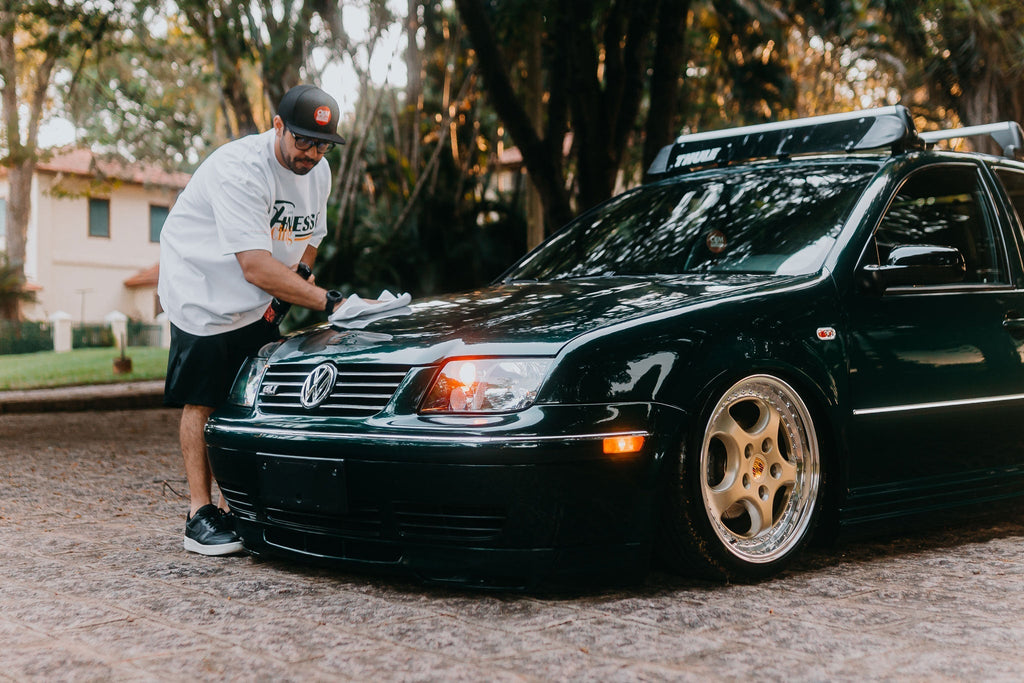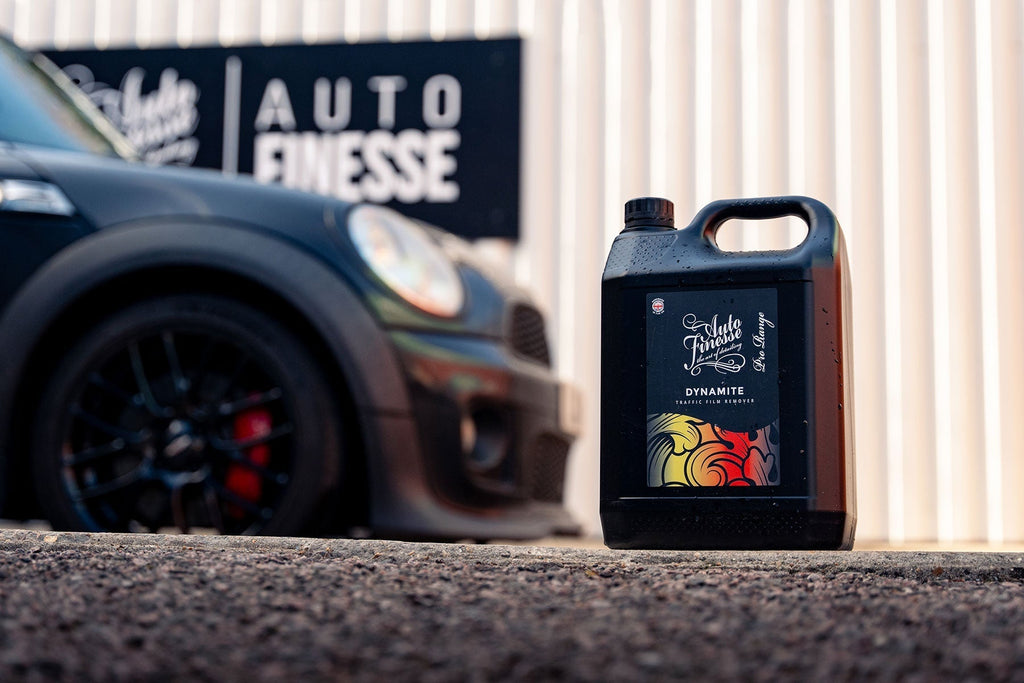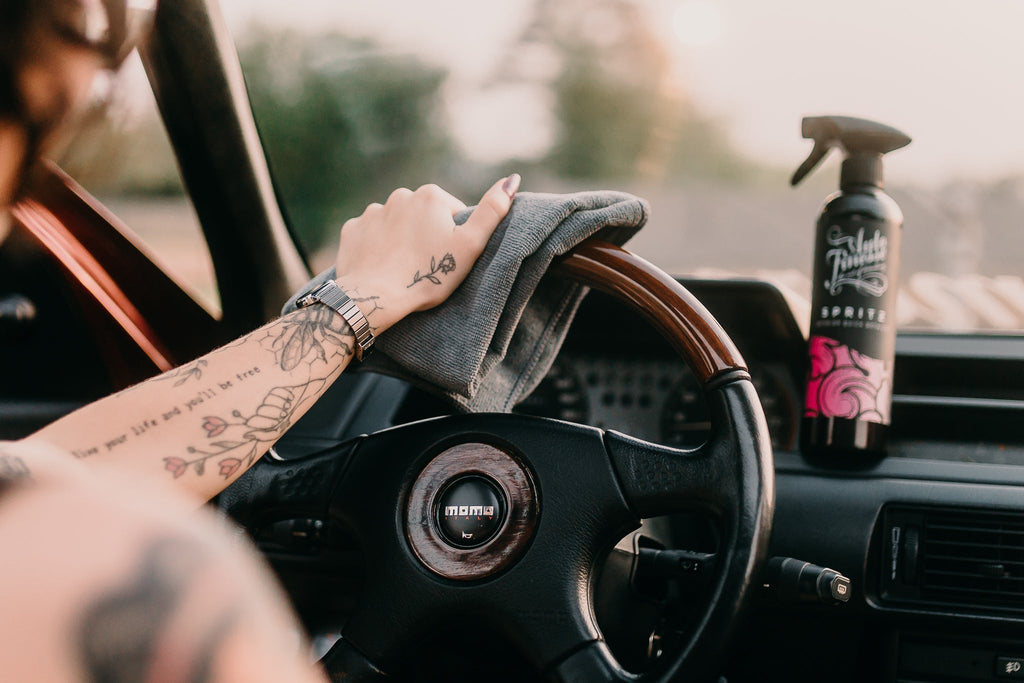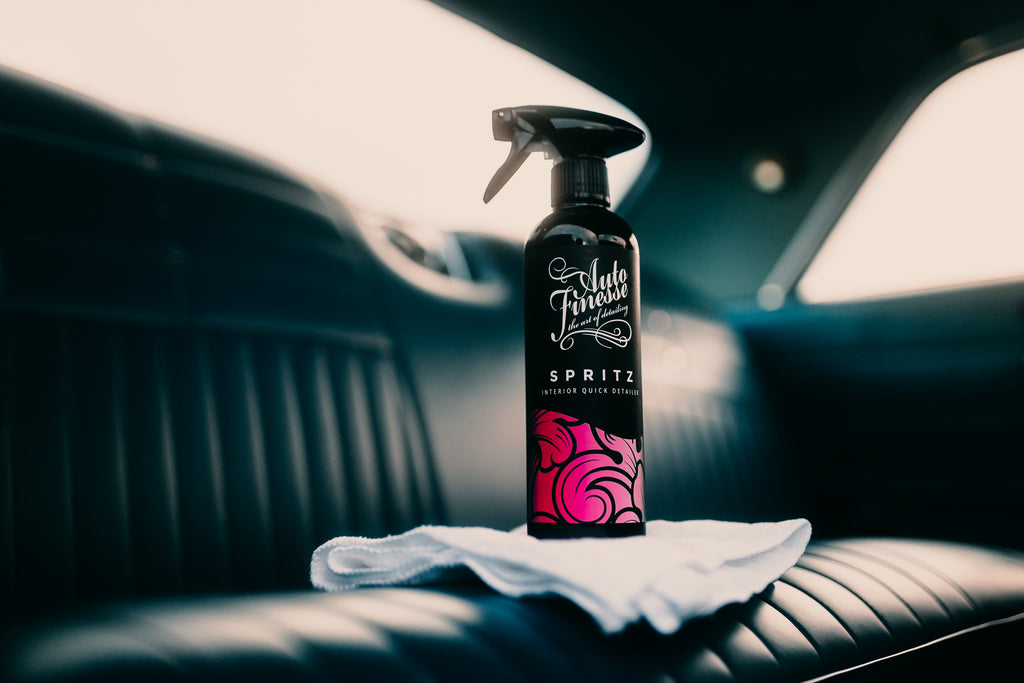Enhancement Detail

In This Guide You Will:
- Discover how to perform an enhancement detail
- Follow a step-by-step guide to improve any gloss paintwork in just a few hours
- Find out why these three essential detailing tools should always be in your kit

Benefits
- A single-stage enhancement detail is quick, simple, and delivers impressive results!
- Save hundreds on professional paint correction and make your vehicle easier to clean in the future.
- With just a few basic products, this process works on nearly any car!
Almost Any Vehicle Can See Improvements From A Simple Polish And Hard Wax Enhancement Detail.
Not every vehicle needs full paint correction, and in fact, most professional detailers will tell you that regularly performing multi-stage compounding and polishing isn’t advisable. You want to preserve some of the clearcoat for when it’s actually needed—typically once or maybe twice a year. One of the golden rules of paint correction is simple: if your paintwork doesn’t need it, don’t do it!
Today, many enthusiasts have mastered the art of washing their vehicle without causing swirl marks, so enhancing paintwork often comes down to removing light, everyday defects and oxidation that may have built up. It's about lightly refining the surface to level the finish and restore that shine that’s even better than factory.
That’s why a periodic single-stage enhancement is always beneficial, especially at this time of year when the rain (hopefully) has stopped, and you can easily get out there with your machine polisher. Sometimes, a simple enhancement over just a few hours is all it takes to bring your paint to a whole new level of refined beauty. And the great news is, we’ve got the perfect trio of essential products to help you achieve that gleaming finish just in time for summer—Tripple All-in-One Polish, a specialty hard wax from our Signature Collection, and our DPX Dual Action Polisher.
Here’s how the pros do it, with answers to all those common questions along the way…

What Is An All-In-One Polish?
Tripple is called an "all-in-one" because its formula includes additional components that give it qualities beyond those of a traditional polish or compound. In other words, it performs multiple tasks, not just fine-cutting and refining paintwork.
Tripple uses abrasives to gently refine and restore clarity, as you'd expect, but it also contains deep-cleansing solvents that help remove oxidation—one of the main causes of faded paint. Additionally, it features glazing agents and a blend of carnauba wax to fill light swirling, mask minor defects, and leave a protective wax layer. Thanks to this unique combination of cleaning, polishing, and protection, Tripple enhances paintwork in a single application.

How Does Tripple Improve Paintwork?
In addition to cleaning away oxidation and actively glazing over blemishes, Tripple can also remove fine swirling, wash marring, and other defects by refining the paintwork through abrasion. This is the more traditional aspect of the product. As a polish or compound, it uses abrasive particles to level the surface around the defect until it reaches the bottom of the imperfection, effectively making it disappear. In this way, it removes scratches and swirls indirectly, which is the core principle behind all paint correction processes.
For more information on different types of polishes and compounds and how they work, check out our in-depth article – All Car Polishes Explained.

Can You Polish With Tripple By Hand?
Most compounds contain abrasives that are hard to break down completely, which is why they typically require a machine polisher to work through the paint efficiently. The abrasive particles in these products can be compared to large, jagged rocks that cut into the paint or clearcoat. As you polish, these rocks grind together, breaking apart and smoothing out, eventually turning into smaller pebbles that no longer cut the surface. When the abrasives stop cutting, that's when the product is fully worked in. While it's technically possible to break down these abrasives by hand, it would take a lot of time and effort to do so effectively. For this reason, using a machine polisher is the most practical approach.
Tripple is different because it contains special diminishing abrasives that break down more easily than those in traditional compounds, making it ideal for hand polishing. You don’t need a machine to speed up the process. So yes, you can definitely hand polish with Tripple, and you'll achieve excellent results.

So, why use a machine polisher with Tripple for a full-body enhancement?
Well, aside from the fact that it eliminates much of the elbow grease, using a machine polisher is a great way to achieve fast, consistent, professional results. The mechanical action of your machine ensures equal coverage on every panel across the entire vehicle. Machines don’t tire out, and they don’t cut corners, so if you want the quickest and most consistent results, using your DPX is a no-brainer. Another advantage of using a dual action machine polisher is the reduced risk of heat build-up compared to a rotary polisher. Essentially, our DPX and MPX dual action machines make it nearly impossible to burn through paintwork. With a machine, you can also adjust how you use Tripple based on the pad you choose. We typically recommend a soft Revitalise No:3 Pad for a great enhancement, but you can also opt for a more aggressive combo with a medium Revitalise No:2 Pad to tackle heavier swirls. As with many aspects of car detailing, the combination you choose can easily be adapted to suit specific needs.

If Tripple Already Contains Carnauba, Why Use A Hard Wax On Top?
In this case, it's all about achieving even better results in terms of gloss and durability. First, the protection offered by Tripple lasts for around a month, which is great. However, because hard waxes have a higher solid wax content, a layer or two of hard wax will last even longer. For example, Illusion Show Wax (which we'll be using later) contains 48% Brazilian carnauba, providing up to 3 months of protection from the elements. It can also be topped up during periodic maintenance washes.
For many, though, using wax is just as much about adding extra gloss to the paintwork. A hard wax does this differently than a polish because it contains no abrasives. While your polish works by mechanically cutting away at the surface to smooth it out, allowing light to bounce back more uniformly, even polished surfaces aren't perfectly flat on a microscopic scale. If you zoom in close enough, you'll see these surfaces are full of ridges and ruts. While they’re smoother than an unpolished surface, they’re still imperfect. A wax, however, leaves a physical layer that fills in those recesses, much like smooth plaster over a rough wall. This new super-smooth top layer levels the optical finish, allowing light to pass through and bounce back more uniformly, without being diffracted in different directions. As a result, the surface appears slicker, wetter, deeper, and glossier.
If you layer up your hard wax with a couple of coats, this effect compounds, giving an even deeper, shinier look. There's also the added benefit that the smooth surface prevents grime and water from sticking, causing them to bead off or sit on top without touching the paintwork, making the vehicle easier to clean during maintenance.
The idea is that, once you've polished your exterior paintwork with Tripple, you'll not only get more protection from a hard wax, but the finish will look and bead better too.

Which Wax Should I Use?
While we offer durable show waxes like Desire, Illusion, Essence, and Fusion—each varying in price, carnauba content, and extreme durability, yet providing stunning results on all paint types—we also have hard waxes tailored for specific applications. For instance, Soul is designed to be highly reflective, making it the perfect choice for lighter colors. Passion is crafted to enhance vintage paint types, while Spirit is ideal for bringing out the sparkle in metallic finishes. Ultimately, the hard wax you choose for your vehicle will depend on the paint finish and, of course, your personal preference.

Half Day Enhancement
As always, the best way to show the process is by doing the job ourselves, and finding a car that could benefit from a quick enhancement isn’t hard. Whether it’s a show car or a daily driver, pretty much any vehicle can benefit—even those that have been corrected before. For this demonstration, we brought in a Mk1 Golf that was in good condition, with just a few light swirls and some minor oxidation. We got to work restoring its immaculate shine.

Wet Work
It’s important to note that before you start polishing any vehicle, it should be thoroughly cleaned, decontaminated, and dried. Don’t worry—the wash and decon stages are included in your half-day time frame. Start early, and you'll be finished by lunchtime—or you can enjoy a relatively easy afternoon of detailing!
Either way, these pre-polishing steps are just as important as the polishing itself. The key is to perform your wet work safely, without introducing defects that would require more work to correct. Be sure to clean tricky areas like shuts and panel gaps to ensure that any grit or grime doesn’t get blown out and interfere with your polishing later on.
To sum it up, follow the proper procedures, starting with wheel cleaning (we're using Imperial Wheel Cleaner), then a pre-wash with Citrus Power Bug and Grime Remover, followed by Avalanche Snow Foam to remove the toughest grit and grime, and finally a 2-bucket wash using Lather Car Shampoo.





Decon Stage
Performing a full 3-stage decontamination to remove embedded and bonded contaminants that washing alone can't tackle is crucial to the success of your enhancement. This is because harmful particles, such as metal shrapnel and bonded mineral deposits, are chemically or physically removed during this process. These contaminants can cause damage if left on the surface, especially when spinning at high RPMs on your polishing pad, so it's important to eliminate them beforehand to avoid potential harm to your paint.
Begin by using Iron Out Contaminant Remover to dissolve metal particles, followed by ObliTARate Tar & Glue Remover for oil-based stains and sticky residues. Finish with claying (using a Clay Bar and Glide Clay Lube) to physically pull out mineral and protein deposits. This 3-stage decontamination process is essential to prep the surface for polishing. For a full breakdown of the procedure, check out our guide – How To Safely Decontaminate Paintwork.
Once the wash and decon are done, and the car is fully dry, mask off any rubbers, handles, grilles, and badges at risk of coming into contact with your polishing pad. Then, you’re ready to begin your paintwork enhancement.



Polishing Stage
As mentioned, you can increase Tripple's polishing performance by switching from a soft to a medium foam pad. After some testing, we decided to go with the medium pad due to the light swirling on this car. Softer pads are ideal for maximum gloss, while slightly firmer pads provide more cutting power. Since we'll be adding plenty of gloss with a wax later on, the most important thing is that the application process remains the same, no matter the vehicle:
- Start by applying 2-3 coin-sized drops of Tripple to your pad.
- Work in a section about 18 x 18 inches (roughly 9 times the size of your pad, square). Set your DPX to the lowest speed setting. Begin the machine while the pad is in contact with the paint to avoid splattering, and spread the product evenly across the panel.
- Use slow, overlapping passes to work the product in, increasing the speed to settings 4-5, applying moderate pressure. Keep the DPX moving at all times, aiming for 2-3cm of movement per second. Continue working until the residue becomes clear.
- Lower the speed setting back to the lowest for a final pass with very light pressure. This step ensures the product finishes smoothly, leaving the surface flawless. Remember to stop the polisher while still in contact with the paint.
- Let the residue haze for a few minutes before removing it with a fresh Microfibre Work Cloth. The results will be immediately noticeable, but it's helpful to inspect with a light source as you go, especially indoors. Our Swirl Spotter Detailing Light is perfect for this.
- Once you've completed one section, move on to the next, continuing until the entire vehicle is finished.
Note: For hard-to-reach areas such as tight spots, door jambs, shuts, tricky bumper sections, small pillars, and under door handles, Tripple can be applied by hand using a microfibre cloth, Polish Pad, or Microfibre Applicator for cleaning and enhancement.





Protecting
This time, we’ve opted for Illusion Show Car Wax to achieve that deep, dripping-wet look—perfectly suited to this type of car. To get the best results from any of our Signature Hard Waxes, we recommend applying them with a soft foam applicator, such as the Waxmate XL or Wax Spot Pad (paired with our Handi Puck Applicator), both designed to fit perfectly inside the wax pots.
A simple quarter turn in the pot is enough to coat your applicator for an entire panel—any more, and you’ll just end up buffing off the excess, wasting valuable wax. The key is to apply a thin, even layer using the "leapfrog" technique: start by waxing the first panel in small, circular motions, then move to the second panel while the first is curing. Once the second panel is done, go back to the first and buff away any residue before giving it a final pass with a fresh side of your cloth to achieve a deep, high-gloss shine. Continue this process, alternating between applying and buffing, until every inch of paintwork is complete.
For buffing, a brand-new microfibre cloth is a must, but for the best results, we recommend using our Micro Tweed Microfibre. Its unique tweed weave helps trap wax residues and prevents clogging, making buffing easier and more effective.
If you're layering wax for added protection and gloss (which we highly recommend), be sure to wait at least three hours between coats. This allows each layer to fully cure and harden, ensuring the next layer bonds properly for maximum durability and shine.







Handi Puck Car Polishing Kit V2. The Handi Puck Car Polishing Kit has been developed to minimise the effort involved in... See product details More


Finishing Up
With the paintwork now enhanced and fully protected, it’s time for those final touches to complete your detail to perfection. After all, you don’t want minor imperfections distracting from your freshly polished finish, right?
Your next steps will depend on how much time you have and how far you want to take your detail. You might opt to cleanse the interior with the powerhouse combo of Total Interior Cleaner and Hide Leather Cleanser, restore faded plastics with Revive Trim Dressing, or bring brightwork, tailpipes, and wheel lips back to life with Mercury Metal Polish.
At the very least, to achieve that fully detailed look, we always recommend dressing your tyres with Satin Tyre Crème or Gloss Tyre Dressing and cleaning your glass inside and out with Crystal Glass Cleaner. These quick and easy steps make a surprising difference, ensuring your vehicle looks its absolute best from every angle.








Our super-advanced, silicone-based tyre shine dressing has been developed to offer a deep, dripping wet look with an ab... See product details More

This is the power of a simple single-stage enhancement—just a couple of hours of machine polishing with Tripple, followed by a layer of wax protection, and the results speak for themselves! A stunning transformation with minimal effort.
If you want to dive deeper into the art of machine polishing, be sure to check out our article – The Basic Guide to Machine Polishing.













Discover the ultimate car polish with Tripple All-In-One Car Polish, designed to deliver outstanding results in record time. This advanced polishing compound is... See product details More





